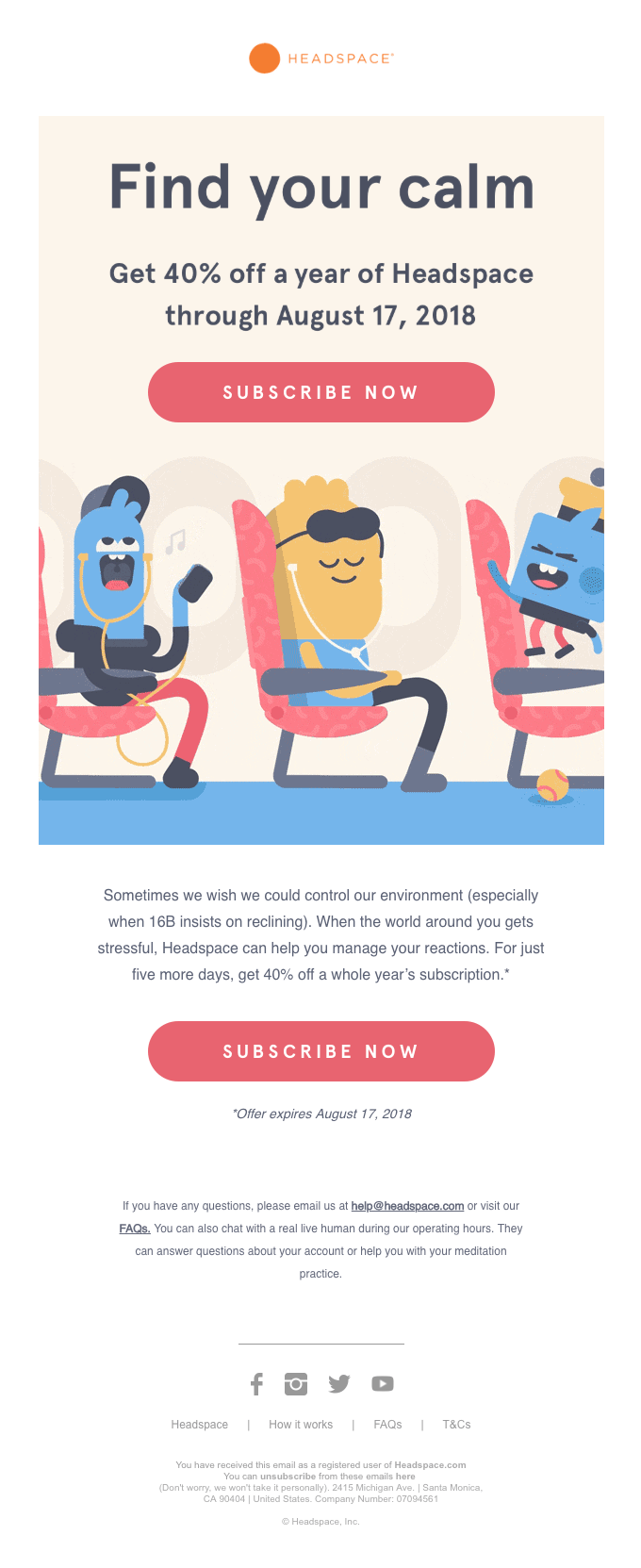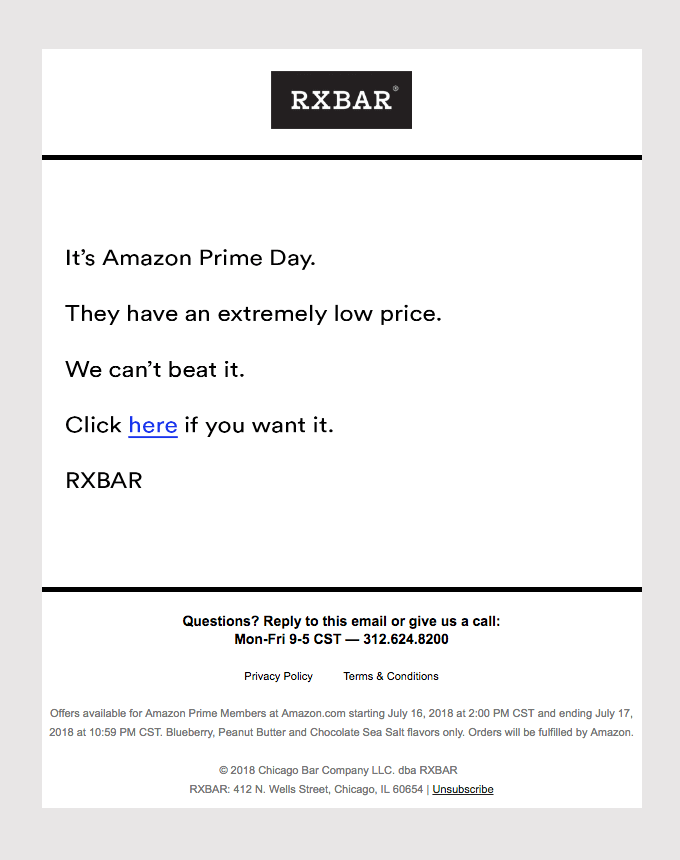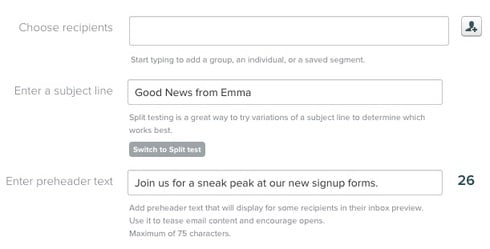How to write a direct marketing email: 10 tips to writing copy that converts
It’s not the next great American novel, but the words in your direct marketing emails matter.
And while digital trends are always shifting and evolving, it’s clear that content remains king. Paired with the fact that 72% of people prefer to receive promotional content by email, we’d dare to say that writing good copy is one of the most valuable skills you can have these days.
But copy that converts? Now that’s next-level.
Why writing matters for marketing emails
You’ve heard it from your high school English teacher and your grandmother who hopes you’ll write thank-you notes but take it from us—writing matters.
In fact, content marketers attributed 78% of their increased industry success to higher quality content creation. Words have significant value, especially when you’re calling the reader to a specific action, like becoming inspired by an idea or understanding their need for a product.
Your guide to writing high-converting email copy
But with that being said, you don’t need to have a master’s degree in English or be able to annotate Shakespeare’s work to write a great direct marketing email.
Toss those flashbacks to sleepless nights spent writing reports and studying for quizzes to the side, because emails are totally different and definitely not worth stressing over.
We’re here to equip you with a few tips to keep in mind as you craft and refine your email copy, and then send you well on your way to delivering inbox genius!
1. Tone deaf doesn’t just apply to music.
First thing’s first: Establish your tone.
Deciding how you want to talk to your readers is the most important piece of your content brand strategy. You can begin by considering how you’d talk to a reader in real life—do you lead with wit? Kindness? Intelligence?
Reference your brand’s values and goals, and then decide what would connect most with your target customers. It’s the same as the difference between a “What’s up?”, “Howdy!”, and “How do you do?”.
See how meditation app Headspace appeals to their customers with a calming tone:
2. Know the difference between they’re, their, and there.
What if we told you that a tiny little typo was the difference between gaining and losing a new customer?
Using spell check and reading over your emails before you send them is like dressing up for a job interview—you’re doing everything you can to make a good impression on your end.
Always get a trusted second set of eyes to look over a draft of your copy before you press send, and bookmark the dictionary difference between “affect” and “effect for reference, just in case.
3. Clarity > Clever
Every good marketer has a few incredible puns or awesome alliterations up their sleeve, but when the average reader is only spending 8 seconds scanning a piece of content, clarity trumps clever.
This means every single word you use has significantly more value, so spend it wisely and efficiently. Pack your phrases with punch and intentionality, and cut anything that adds fluff or confusion to your message. Clarity drives conversions, not cliches or cleverness. (We’re all for personality and wordplay, just make sure it has a purpose!)
See how RX bar keeps their email about Amazon Prime Day clear and to-the-point:
4. Give the reader something for their time.
Incentives don’t always have to be monetary. When a reader knows emails from you will be full of useful information, helpful tips, lighthearted entertainment, or exciting news, they’ll look forward to seeing your name pop up in their inbox.
Set your reader’s expectations from the beginning about what they will be receiving, then meet (and exceed!) them with content that is valuable and worth their time. And when there’s nothing going on? Spend time creating value or skip sending until you have something to share that’s worth your reader’s time.
5. Keep it short.
As we mentioned before, you’ve got 8 seconds. This isn’t time for the life story of your business or a full commentary on current events.
Each email should have one purpose, and every letter, word, and sentence should point to that end goal. Emails are an opportunity to give the reader a sample experience of the fullness your company has to offer—you don’t want to hand it all over right away, but keep them excited and coming back for more.
6. Consider every email element.
When sending emails, most people only consider the actual body copy of the message. However, there are several elements of an email that, when used correctly and cohesively, can help you grab a reader’s attention and convert them into a customer.
The areas other than the body copy you’ll want to focus on are the sender field, subject line, preheader text, and call-to-action button We have a few ideas for each one below:
7. Who is the email from?
Obviously, we know that the email is from you. But filling out the “From” section in your email creation process is actually a significant decision you should put some thought into.
While you may automatically fill in this field with your company name, we’ve found that open rates can increase when they are from a real person’s last name (like mine, Kaitlin Wernet) instead of the company name (like Emma).
We think this happens because it seems a lot more authentic, like a personal correspondence from a friend, and when the expectations are set this way, subscribers are more likely to interact with your content like they would a letter from someone familiar.
8. Use an inviting subject line.
This is a topic that could begin a pretty heated debate between email marketers—how many words should be in a subject line? What’s the best technique for grabbing a subscriber’s attention?
So let’s set down the formulas for a minute and consider the main idea here: The subject line is an enticing invitation for your reader to open your email. Don’t lazily approach it with the assumption they’ll open it no matter what, but also don’t be too demanding and forget they’re human, too.
Our best top for subject lines is to go back to the main goal of your email, and craft a subject line that expresses that in your company’s unique voice.
In other words, be yourself. You’ve got this. And if you need a little inspiration, here are 9 subject lines that stood out to us and 5 subject line mistakes that are killing your open rates.
See how Madewell uses personalization and a simple message to remind their customers to not miss out, and the preheader text nods to what the email is about:
9. Don’t forget preheader text.
Together, the subject line and preheader text are #relationshipgoals. The Beyonce and Jay-Z of email marketing.
They work together and complement each other’s strengths to make one compelling argument to convince a reader to open your email. And the best part? If you do it correctly, they won’t even know it’s happening, kind of like when Queen Bey drops a surprise album.
When you’re looking at your own email inbox, the preheader text is the preview of the email text that appears under the subject line. In a traditional email, this is where you’ll see the first part of the message you’ve received. But because you’re an email marketing pro, you can customize this text to maximize time with your reader and really emphasize a message that converts.
Taking advantage of the opportunity to customize preheader text is like getting a little head start on sharing your message before the email is even opened. Use preheaders to tease the content of your email, write a personal message, give an incentive to open, or A/B test copy to see what your subscribers respond to best.
10. End with a clickable CTA.
When was the last time you clearly remember receiving an email and immediately wanting to take them up on their offer? What was it that made it so appealing? Now thinking about this in reverse, how can you apply that same feeling on the other end of the equation, actually writing the call-to-action?
We like to say that click-worthy call-to-action buttons are 50% great offer, 50% compelling copy. The CTA should sum up your message and make sense to both those who read the entire email word-for-word and those who skimmed. A few examples of spot-on CTAs that are direct yet inviting:
- “I’m ready to see a change.”
- “Let us know how we did.”
- “Get results now.”
- “Save me a seat.”
- “Claim your birthday coupon.”
This is another great opportunity for A/B testing—send a few different buttons with different CTAs and find out the ones that convert the most. Isn’t it crazy how just a few words can drive a significant customer action? It’s all in the power of your words!
Wrap up
The best part about writing direct marketing copy for email? The more you do it, the better you’ll get. Continue refining your brand voice, test different versions of your message, and always remember to maximize every element of your email.
As the quality of your content continues to increase, your customer conversions and enjoyment will, too. Oh, and not to mention, you’re making all of your former English teachers beyond proud. Happy writing!
MOST RECENT ARTICLES
Want to engage your audience and grow your brand? Try Emma's robust easy-to-use product today.
















